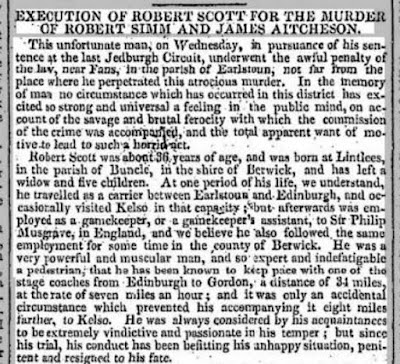The end of the First World War came at the 11th hour of the 11th day of the 11th month – 11th November 1918.
“The Southern Reporter” of November 14th shared the good news:
“The Berwickshire News" gave a much fuller report of the celebrations in Earlston:
“On Monday the news came though that the German delegation had signed the armistice. The first indication of the news was the sounding of the factory buzzer – a sign that something unusual had happened. Then closely followed by the bell of the Parish Church and the Corn Exchange, the raising of the flag at Rhymer’s Mill and the display of flags and bunting throughout. Factory workers were given a half holiday and the whole place was moved and stirred by the welcome news.
Between 12 and 1pm, a thanksgiving service was held in the Parish Church Hall conducted by the Rev. Walter Davidson in a manner highly acceptable to the large gathering of men and women. Groups of people gathered on the streets to discuss the joyful news.
In the evening there was an impromptu concert in the Corn Exchange with money raised going to the Earlston Comforts Fund".
***********
THE AFTERMATH OF WAR
1918 - The Spanish Flu Epidemic: During the pandemic of 1918/19, over 50 million people died worldwide and a quarter of the British population were affected by this deadly virus, which was first reported from Spain. It hit people who had endured austerity and food shortages due to the war, and it was before the advent of antibiotics and anti-virus medicine. The death toll was 228,000 in Britain alone.
"The Southern Reporter" of 28th November 1918 reported on the fourth week of closure of the school due to the influenza epidemic, with the church also closed for the previous two Sundays.1919- Peace Celebrations: These were held across Berwickshire on 19th July 1919. In Earlston a grand picnic and sports day was held at Cowdenknowes, courtesy of Colonel Hope, followed in the evening by the lighting of a beacon on the Black Hill and a grand display of fireworks which excited the crowd.
Berwickshire News: 15th July 1919
1920 - Welcome Home Dinner: "Welcome home to the returned soldiers, sailors and women's auxiliary of Earlston parish and district".
This was the greeting on the
23rd of April 1920, when Earlston paid tribute to its serving men and
women of the First World War, by hosting a dinner in their honour in
the Corn Exchange. Chairman
for the occasion was Colonel Hope of Cowdenknowes, and the dinner was
followed by the toasts and a programme of musical entertainment, with
cigarettes provided by Mrs Mitchell of Carolside.
This souvenir programme is in the collection of Auld Earlston.
This particular card bears the name of H. R. Aikman, 2nd Lieut. K.O.S.B. i.e. Henry Aikman who also gave a reply to the toast to "The Boys who Fought and Won", and was on the Earlston War Memorial Committee.
Henry had a very close' personal connection with the occasion. He, his twin brother William and older brother James all served in the First World War with the Kings Own Scottish Borderers. William
had worked at Rhymer's Mill, served in the Earlston Territorials as
bugler, was a renowned shot and an active member of Earlston Rugby Club, Golf Club and Bowling Club. But he was presumed killed on 12th July 1915 in the Dardanelles Campaign. He is remembered on the Helles Memorial in Turkey and on Earlston War Memorial.
Women were also included in the event, but unfortunately we know nothing about the women from Earlston who served in the First World War, most likely as nurses.
1921 -Unveiling of the War Memorial

In the 1911 census, Earlston's population stood at 1749, with 801 male and 948 females. The First World War saw forty-nine men losing their lives in the conflict - their names recorded on the War Memorial, unveiled on Sunday 13th November 1921. In a service of dedication in
the square, it was unveiled by Mrs Hope, wife of
Colonel Hope of Cowdenknowes, who was chairman of the War Memorial Committee,
************

Earlston War Memorial, November 2017

November 2018 - Earlston's Fall of Poppies

November 2018 - Earlston's Fall of Poppies
in commemoration of the end of the Great War one hundred years ago.
Created by members of Earlston Parish Church.
Primary 6 & 7 pupils gather for a short ceremony at the War Memorial
7th November 2018
Created by members of Earlston Parish Church.
Primary 6 & 7 pupils gather for a short ceremony at the War Memorial
7th November 2018






















 d.
d. 



